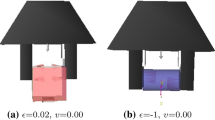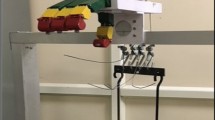Abstract
Continuum robots (CRs) have shown a wide range of potential applications from the medical industry to rescue missions. CRs form curves with continuous tangent vectors and have unlimited degrees of freedom (DOFs), which make them underactuated structures. The underactuation and compliance of CRs cause the adaptability and robustness of CR-based grasps. However, fundamental issues related to the grasp quality evaluation of CRs have yet to be investigated. This paper synthesizes an underactuated grasp of CRs on an arbitrary-shaped grasped object using a constant curvature model. The technique relies on parallel global grasp quality measures based on the grasp configuration and grasp tasks. Then, a numerical example of an underactuated tendon-driven CR-based grasp is investigated to show the validity of the grasp synthesis approach. Finally, the experimental results are reported in which a practical grasp quality measure (i.e., grasp success rate (GSR)) was used for validation. To this purpose, Taguchi method is applied to design the experiments by reducing the number of trials. The designed tests are performed using our robot-assisted catheterization systems (RACS), Althea I and II. Also, the effectiveness of using Taguchi method instead of the full factorial experiments in designing the verification process is presented and discussed.









Similar content being viewed by others
Explore related subjects
Discover the latest articles, news and stories from top researchers in related subjects.Availability of data and material
Not applicable.
Code availability
None.
References
Bryson Black C (2017) Modeling, analysis, force sensing and control of continuum robots for minimally invasive surgery. Ph.D. thesis, University of Tennessee
Jung J, Penning RS, Zinn MR (2014) A modeling approach for robotic catheters: Effects of nonlinear internal device friction. Adv Robot 28(8):557–572
Lotfavar A, Hasanzadeh S, Janabi-Sharifi F (2017) Cooperative continuum robots: concept, modeling, workspace analysis. IEEE Robot Autom Lett 3(1):426–433
Norouzi-Ghazbi S, Mehrkish A, Janabi-Sharifi F, (2020) Jacobian formulation for two classes of cooperative continuum robots. In: Proc. of the Canadian Society for Mech. Eng. Int. Cong. (CSME), pp. 3–8
Giri N, Walker ID (2011) Continuum robots and underactuated grasping. Mech Sci 2(1):51–58
Prattichizzo D, Malvezzi M, Gabiccini M, Bicchi A (2012) On the manipulability ellipsoids of underactuated robotic hands with compliance. Robot Auton Syst 60(3):337–346
Li J, Teng Z, Xiao J, Kapadia A, Bartow A, Walker ID (2013) Autonomous continuum grasping. In: Proceedings of the IEEE/RSJ international conference on intelligent robots and systems, pp 4569–4576
Li J, Xiao J (2013) Progressive generation of force-closure grasps for an n-section continuum manipulator. In Proceedings of international conference on robotics and automation, pp 4016–4022
Li J, Xiao J (2011) Determining ‘grasping’ configurations for a spatial continuum manipulator. In: Proc. IEEE Int. Conf. Intell. Robots Syst, pp. 4207–4214
Mehrkish A, Janabi-Sharifi F (2021) Grasp synthesis of continuum robots. Mech Mach Theory 168:104575
Roa MA, Suárez R (2014) Grasp quality measures: review and performance. Auton Robots 38(1):65–88
Mehrkish A, Janabi-sharifi F (2021) A comprehensive grasp taxonomy of continuum robots. Robot Auton Syst 145:103860
Camarillo DB, Carlson CR, Salisbury JK (2009) Task-space control of continuum manipulators with coupled tendon drive. IEEE Trans Robot 54(4):271–280
Dupont PE, Member S, Lock J, Itkowitz B, Butler E, Member S (2010) Design and control of concentric-tube robots. IEEE Trans Robot 26(2):209–225
Jabari M, Zakeri M, Janabi-Sharifi F, Norouzi-Ghazbi S (2021) Inverse kinematics of concentric tube robots in the presence of environmental constraints. Appl BionBiomech, pp 1–12
Hisch F, Giusti A, Althoff M (2017) Robust control of continuum robots using interval arithmetic. IFAC-PapersOnLine 50(1):5660–5665
Sahbani A, El-Khoury S, Bidaud P (2012) An overview of 3D object grasp synthesis algorithms. Robot Auton Syst 60(3):326–336
R. Suarez and J. C. Maximo Roa, “Grasp quality measures,” Syst. Sci., vol. 24, no. 2, pp. 71–86, 2006.
Rafidah A, Nurulhuda A, Azrina A, Suhaila Y, Anwar IS, Syafiq RA (2014) Comparison design of experiment (DOE): Taguchi method and full factorial design in surface roughness. Appl Mech Mater 660:275–279
Singh PK, Krishna CM (2014) Continuum arm robotic manipulator: a review. Univ J Mech Eng 2(6):193–198
Lee C et al (2017) Soft robot review. Int J Control Autom Syst 15(1):3–15
Ganji Y, Janabi-Sharifi F (2009) Catheter kinematics for intracardiac navigation. IEEE Trans Biomed Eng 56(3):621–632
Iii RJW, Okamura AM, Cowan NJ (2006) Toward active cannulas: miniature snake-like surgical robots. In: Proceedings of the IEEE/RSJ international conference on intelligent robots and systems, pp 2857–2863
Baard J, De Bruin DM, Zondervan PJ, Kamphuis G, De Rosette J, Laguna MP (2017) Diagnostic dilemmas in patients with upper tract urothelial carcinoma. Nat Rev Urol 14(3):181
Izzo F et al (2015) Hepatocellular carcinoma and liver metastases: clinical data on a new dual-lumen catheter kit for surgical sealant infusion to prevent perihepatic bleeding and dissemination of cancer cells following biopsy and loco-regional treatments. Infect Agents Cancer 10(11):1–7
Francis R, Lewis C (2018) Myocardial biopsy : techniques and indications. Heart 104(11):950–958
Moya-Plana P, Bresson A, Missistrano D, Temam A, Gorphe S (2019) Multiportal approach to skull base combining endoscopic transnasal surgery and transoral robotic surgery with Da Vinci Xi system: Feasibility assessment and clinical cases. J Neurol Surg Part B Skull Base 80(1):157
Hunt AJ, Bachmann RJ, Murphy RR, Quinn RD (2011) A rapidly reconfigurable robot for assistance in urban search and rescue. In: Proceedings of the IEEE/RSJ international conference on intelligent robots and systems, pp 209–214
Scholl K, Kepplin V, Berns K, Dillmann R (2000) Controlling a multijoint robot for autonomous sewer inspection. In: Proceedings of the IEEE international conference on robotics and automation (Cat. No. 00CH37065), pp 1701–1706
Axinte D et al (2017) Development of a slender continuum robotic system for on - wing inspection / repair of gas turbine engines. Robot Comput Integr Manuf 44:218–229
Mehling JS, Diftler MA, Valvo M (2006) A minimally invasive tendril robot for in-Space inspection. In: Proceedings of the IEEE/RAS-EMBS international conference on biomedical robotics, pp 690–695
Webster RJ, Jones BA (2010) Design and kinematic modeling of constant curvature continuum robots: a review. Int J Robot Res 29(13):1661–1683
Trivedi D, Rahn CD, Kier WM, Walker ID (2008) Soft robotics: Biological inspiration, state of the art, and future research. Applied Bionics and Biomechanics 5(3):99–117
Rus D, Tolley MT (2015) Design, fabrication and control of soft robots. Nature 521(7553):467–475
Li J, Xiao J (2016) Progressive planning of continuum grasping in cluttered space. IEEE Trans Robot 32(3):707–716
Sadati SH, Naghibi Seyedeh E, Shiva A, Walker ID, Kaspar A, Nanayakkara T (2017) Mechanics of continuum manipulators , a comparative study of five methods with experiments. In: Proc. Annu. Conf. Towar. Auton. Robot. Syst, pp 686–702
Renda F, Boyer F, Dias J, Seneviratne L (2016) Discrete Cosserat approach for multi-section soft robots dynamics. IEEE Trans Robot 34(6):1518–1533
Oliver-Butler K, Till J, Rucker C (2019) Continuum robot stiffness under external loads and prescribed tendon displacements. IEEE Trans Robot 35(2):403–419
Jones BA, Gray RL, Turlapati K (2009) Three dimensional statics for continuum robotics. In: Proceedings of the IEEE/RSJ international conference on intelligent robots and systems, pp 2659–2664
Prattichizzo D, Trinkle JC (2008) Handbook of Robotics (Chapter 28: Grasping). Springer, Heidelberg, Berlin, Germany
Walker ID (2013) Continuous backbone ‘continuum’ robot manipulators. ISRN Robot 2013:1–19
León B, Morales A, Sancho-Bru J (2014) From robot to human grasping simulation. Springer, Cham
Norouzi-Ghazbi S, Akbarzadeh-T A, Kardan I (2018) Statistically optimized FOPID for output force control of SEAs. Adv Robot 32(5):231–241
Norouzi-Ghazbi S, Akbarzadeh-T A, Akbarzadeh-T MR (2020) “Application of Taguchi design in system identification: a simple, generally applicable and powerful method. Meas J Int Meas Confed 151:106879
Norouzi-Ghazbi S, Janabi-Sharifi F (2020) Dynamic modeling and system identification of internally actuated, small-sized continuum robots. Mech Mach Theory 154:104043
Ismail NA, Ismail MIS, Radzman MAM, Ariffin MKAM, As’arry A (2019) Parametric optimization of robot-based single point incremental forming using Taguchi method. Int J Integr Eng 11(1):217–224
Norouzi-Ghazbi S, Mehrkish A, Abdulhafiz I, Abbasi-Hashemi T, Mahdi A, Janabi-Sharifi F (2021) Design and experimental evaluation of an automated catheter operating system. Artif Organs 45(6):E171–E186
Hester RD, Cetin M, Kapoor C, Tesar D (1998) A criteria-based approach to grasp synthesis. Master’s thesis, University of Texas at Austin
Roa MA, Suárez R (2009) Computation of independent contact regions for grasping 3-D objects. IEEE Trans Robot 25(4):839–850
Acknowledgements
This work was sponsored by the National Sciences and Engineering Research Council of Canada (NSERC) through Discovery Grant # 2017-06930. The authors would also like to acknowledge the assistance of Dr. A. Cheema in the clinical aspects of the work.
Author information
Authors and Affiliations
Contributions
Conceptualization was contributed by Ali Mehrkish; Methodology was contributed by Ali Mehrkish; Formal analysis and investigation were contributed by Ali Mehrkish, Somayeh Norouzi-Ghazbi, and Masoud Goharimanesh; Writing—original draft preparation was contributed by Ali Mehrkish; Writing—review and editing was contributed by Ali Mehrkish, Somayeh Norouzi-Ghazbi, Masoud Goharimanesh, and Farrokh Janabi-Sharifi; Simulations were contributed by Ali Mehrkish; Experimental evaluation was contribution by Somayeh Norouzi-Ghazbi and Ali Mehrkish; Design of experiments and Taguchi implementation were contributed by Masoud Goharimanesh and Ali Mehrkish; Supervision of the project was contributed by Farrokh Janabi-Sharifi; Funding acquisition was contributed by Farrokh Janabi-Sharifi.
Corresponding author
Ethics declarations
Conflicts of interest
None.
Ethical approval
Not applicable.
Consent to participate
Not applicable.
Consent for publication
Not applicable.
Additional information
Publisher's Note
Springer Nature remains neutral with regard to jurisdictional claims in published maps and institutional affiliations.
Appendices
Appendix A: The Jacobian components of each CR
The components of Jacobian of the ith CR, \(J_{jk}\) are as follows.
where j and k are number of rows and columns of the J component.
Appendix B: Kinetics and Equilibrium
To investigate the kinetics of the CR-based grasp problem, the equations of motion for both robot and object are considered as follows
where \({\mathbf{M}}_{r}\) and \({\mathbf{M}}_{obj}\) express inertia matrices for the engaged robot and object, respectively, and \({\mathbf{b}}_{r}\) and \({\mathbf{b}}_{obj}\) indicate their velocity-product terms. Moreover, contact forces, generalized joint forces, and total wrench applied on the object are shown with f, \({\mathbf{T}}\), and \({\mathbf{w}}_{{\rm ext}}\), respectively.
Equations (A2) and (A3) represent the dynamics of the Co-manipulative CR and object without regard for the kinematic constraints imposed by the contact models in Eq. (17). Enforcing them, and considering rigid body kinematics of the manipulation system, the dynamic model of the system will be:
2.1 Quasi-static model
A quasi-static model assuming a slow-motion is used to simplify the equations as follows
disregarding the time-dependent and inertia terms. Finally, Eqs. (8) and (A5) lead to.
which can be written in a compact form as
These relationships will lead to the basic grasp classification concept [40], which will be the topic of our future work.
Rights and permissions
Springer Nature or its licensor (e.g. a society or other partner) holds exclusive rights to this article under a publishing agreement with the author(s) or other rightsholder(s); author self-archiving of the accepted manuscript version of this article is solely governed by the terms of such publishing agreement and applicable law.
About this article
Cite this article
Mehrkish, A., Janabi-Sharifi, F., Goharimanesh, M. et al. Multiple aspects grasp quality evaluation in underactuated grasp of tendon-driven continuum robots. Intel Serv Robotics 16, 33–48 (2023). https://doi.org/10.1007/s11370-022-00449-z
Received:
Accepted:
Published:
Issue Date:
DOI: https://doi.org/10.1007/s11370-022-00449-z




